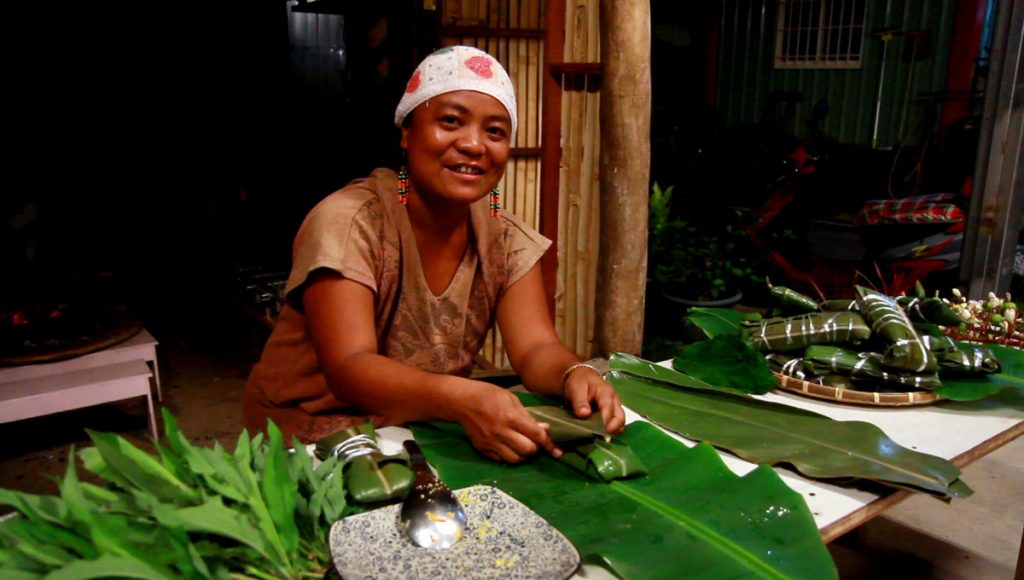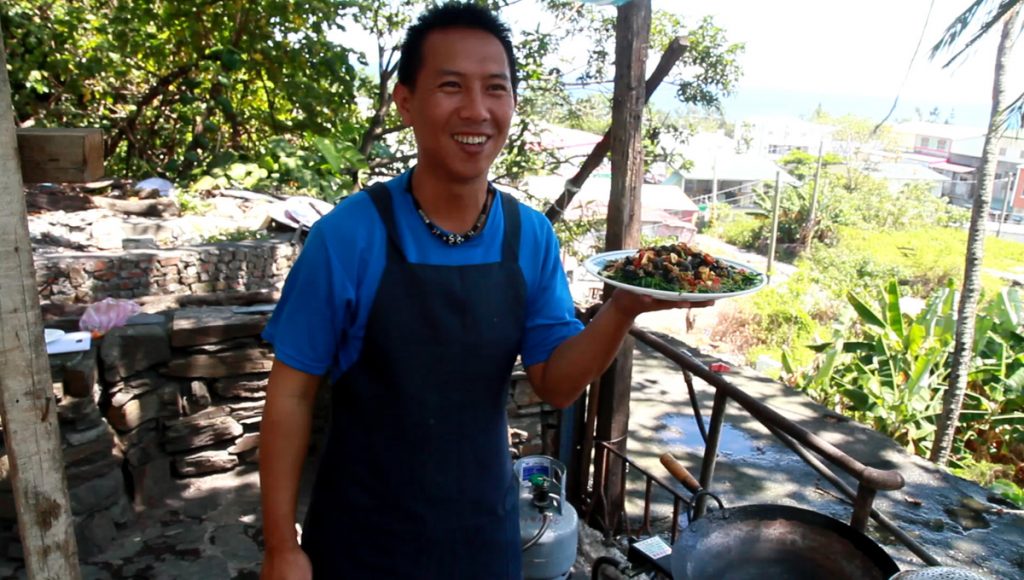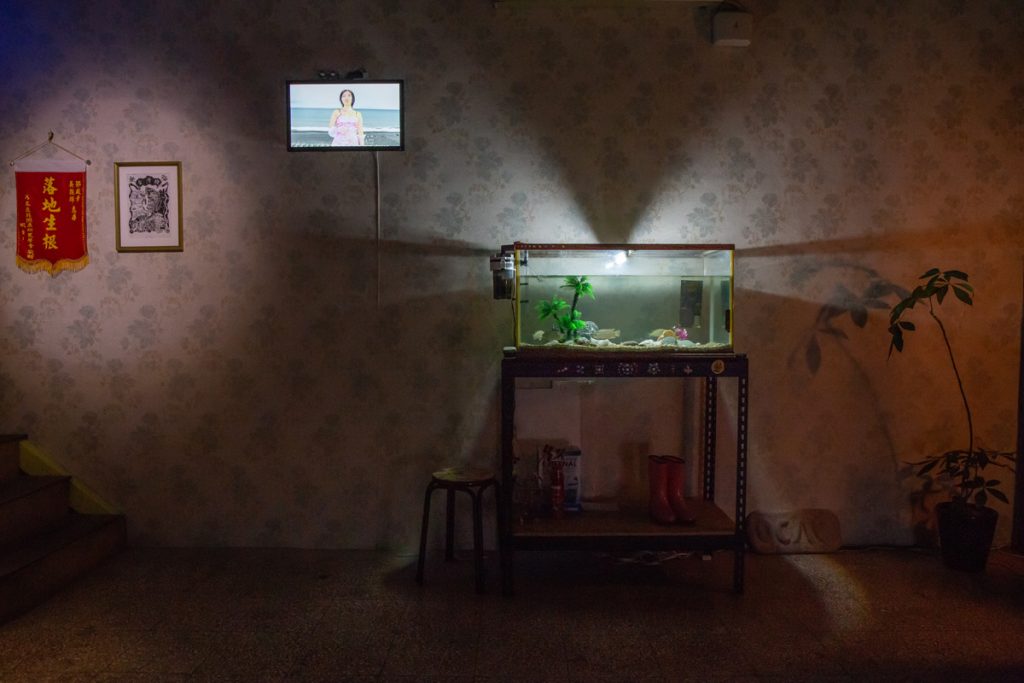Browse
From 2009 to 2013, I have completed a series of 6 snail-themed art projects, which engaged cooking as a point of departure to expand the notions of savour, flavour and delight. These notions can be summed up as one English word – ‘taste’, however, its other definition – ‘preference’ has a more profound interpretation. Taste informs the lifestyle in different communities; the choice of what we eat symbolizes our class consciousness and symbolic capital. As we trace the slime of the snail trail, perhaps, certain keywords introduced by French sociologist and philosopher (Pierre Bourdieu, 1930-2002) in his theories will keep recurring. This article intends to reimagine a series of social milieus through his theoretical framework; while analogizing them with other artworks to explore the possibilities to engage art as an agency to subvert its existing class module.
Achatina fulica in Taiwan
The Achatina Fulica started its great navigation from East Africa to the Indian Ocean, had a brief stopover in Singapore, before arriving in Taiwan through the South China Sea. Its adventure symbolises the propagational expansion path of an empire.
In 1933, when the health technician from the Taiwan Governor’s office, Shimojo Kumaichi(註1) first laid his eyes on Achatina Fulica in Singapore during the League of Nations Health Department Asian Convention, he was immediately arrested by this creature, and with the help from his high-ranking position in the Governor’s office, he managed to find the loophole in the quarantine process to bring the Achatina Fulica to Taiwan. He then teamed up with Tazawa Shingo, Shimojo Kumaichi and other businessmen to promote edible snail farming. However, once the business hype has faded, the snails were mostly abandoned or escaped, which ended up invading the local crops, and continue to threaten both the Taiwanese natural ecosystem and the local farming industry(註2). The global omnipresent Achatina Fulica is notoriously known as the top 100 foreign invasive species in the world.
It is almost unthinkable to consider Achatina Fulica as food. Many are disgusted by its slimy outlook, like a slow-crawling alien on a rainy day. Its body is packed with various bacteria and parasites and it is potentially poisonous while consumed(註3). In the early Taiwanese agrarian society, the snail was not an uncommon dish for the lowly-paid; savouring snail has now become a part of generational collective memory since the Taiwanese economic boom. Now, however, it is still a common dish among the Taiwanese indigenous people, and farmed-snails in cages are easily sighted in the settlements. These settlements are usually located in remote areas. Compared to the general mass, these geographical positions are considered marginal, it’s marginality delineates boundaries, and such boundaries demarcate the divide of social classes. The subject of snail in this series works as an explicit interface to recount my maternal root to the Taiwanese indigenous people.
The Snail Playground
When I was young, my separated mother used to collect and clean the snails then apportion to the kids she could not be with. These snails kept piling up in my freezer until I decided to make my first snail project – “The Snail Playground”. I stuck the Taiwanese iconic architectures onto the shell of the snails and put them on a Taiwan island-shaped vegetable mound. It is fascinating to observe these landmarks slowly shifting as they crawl around. Fixing an architectural model onto the shell of snail draws reference to the protest on the preposterous property price during the Shell-less Snail Movement(註4). The selected architecture includes Taipei 101 and a few authoritarian building such as the Sun Yat-Sen Memorial Hall and Cheng Kai-Shek Memorial Hall. This supposedly light-hearted work is also burdened by the tension of the capitalist class system, hence, making the initial idea and its articulation ambiguous.
Later, by emulating the way my indigenous mother prepare a snail dish, I made a live art performance called “Body and Food (2010)” at the Hong-Gah Museum. I started the performance by inviting the guests to sample the ‘stir-fried escargot’ with beer, then I revealed what they really had. The audience was in a state of shock. In 2012, I started an interview project on snail related cuisine, with snails as the main cooking ingredient to complete a cultural survey of the island. The first video “Chun Shan (Aphrodite; 2012)”, featured a French cuisine chef and the three other video works later “the Snail Cuisine Interview Project – Provincial Highway 9 (2013)” focused on South Eastern Taiwan, including Taimali Township, Daren Township, and Dawu Township in Taitung County, areas where the Provincial Highway 9 runs through and where most Paiwan tribe resides. The solo exhibition Chang En-Man│Snail Playground in 2013 concluded with a series of projects and the snail-related discussions.
Snail and Taste
The more sophisticated work in terms of taste in the snail series is “Chun Shan (Aphrodite)”, in which the title was adopted from the title of the Chilean woman writer Isabel Allende’s eponymous novel, suggesting certain food’s ability to enhance sexual desire and improve performance. Snail is from the Mollusca family, its wriggling motion and slimy body have a physical and sensual connotations. “Chun Shan” talks about the sexual desires of the modern urban men and women, whereby French cuisine represents the taste of metropolitan well-to-do. If there is a grading system for the social classes, then French cuisine would be for the bourgeoisie and the upper class. The difference between the famous French baked burgundy snail and the local stir-fried escargot in “Body and Food” is that the former reveals its ingredient explicitly with a high price tag, yet the latter is a kind common street food that doesn’t dare to reveal its ingredients. This naming exercise reflects the idiosyncrasy in our societal realm.
“Chun Shan” in Chang En-Man│Snail Playground works as an accompanying piece for “414km from Highway No,9”. By featuring the cooking process of the French cuisine chef in against the youths of the Paiwan tribe, it forms a strong contrast between these two projections. Provincial Highway 9 is the only highway in the area. I named my sub-projects based on the distance markers on the highway and invited the local indigenous people to demonstrate how to prepare a snail dish for us. The head chef for “414km” is the leader of the local indigenous youth association, who organises youth activities such as preparation for wedding, funeral and celebratory event, traditional dance rehearsal and performance, as a way to impart traditional values and reconnect with the already fragmented local culture with the young while nurturing a stronger sense of identity. “414km” was a seemingly casual yet serious cooking project, due to economic constraints they chose cheaper ingredients for the creatively improvised dish, and the leader of the group would order his sidekicks to do grocery shopping. This indirectly revealed the hierarchical power structure within the group. The existing group units that are formed with social groups have their ways of being; the way of how group members maintain sorts of direct or indirect relationship has a certain degree of sense of belonging (hierarchy)(註5).
The advancement in food preservation technology starts by masking the muddy smell of the snail with red wine and spices, using fungus to accentuate its original earthy taste and to simulate the actual snail trail in plating. “Chun Shan” paid extra attention to Cuisinart, to elevate symbolic capitals while satisfying the bourgeoisie diners. “414km” stresses on the readily available snails as a source of free protein, it nourishes the indigenous people and satisfies the social need to share. The rural and the urban have a distinctively different approach towards food and taste. The difference in ‘taste’ represents the differentiation standard in class, and in part forms the identity and social status. Taste can be analyzed and it is decided by society at large. Each individual’s taste in art, music and choice of cuisine, and their social status are determined by the practice of social classes(註6).

Habitus as the foundation of individual and group behaviour is formed by the experiences between individual and collective(註7); habitus is an ongoing preferential system formed in the process of socialization of the individual(註8). The protagonists both of the videos in the series “Provincial Highway 9: 423km Turn East 68-”1 and “433km” used to live and work in the city or outskirt of the city, and later decided to return to their hometowns respectively. The head chef in “423km Turn East 68-1” used to be a soul music singer in pubs and grew up with western music. He had trouble adapting due to the change of environment and cultural differences, but when it comes to cooking, through his childhood memories with his great grandmother, he made the much cherished traditional food – qavay (millet cake dumpling), to underline the practice of unequal exchange of labour in the early days.
The head chef of “443km” is the mamazangilan (tribal leader, chief) in Dawan village; he and another 13 villagers lost their home during the Typhoon Morakot(註9) and he initiated self-rescue group with tents set up in the village community center to advocate for their rights to settle peacefully. To recall memories of his great grandmother is a way to reconnect with the matriarchal system. The tent that shapes like snail’s gastropod becomes the tool and means to demonstrate the will for not wanting to be uprooted. This perseverance shows the practical values of behavioural tendency and internalization.

Food culture symbolises our upbringing and ideologies, taste and preference in individual or communities often match their social position; charting cultural geography through different species and cuisines. Does the recurring title of Snail Playground really suggest a way towards the so-called Utopia? By looking at similar practices with different motivations, I aim to draw up an overview map of similar practices.
Hey! Crawler brothers and Foreign Species
For the Theater of The World (1993) exhibition, Chinese artist Huang Yong Ping made an enclosed turtle-shaped installation which works as a panopticon to survey hundreds of thousands of reptiles and bugs fighting for theirs own vicious survival. The curator, Qiu Zhijie, believes that the world portrayed by Huang Yong Ping is a reckless jungle before the form of order is found; or after the deconstruction, the world before the doomsday(註10) – this form of battle is not any different to the one between social classes.
Shimabuku reflects on the notions of ‘stay’ and ‘return’ and his desire to divert from the loss path of civilization progress to return to an imagined ancient world through the turtle in his work, “My Teacher Tortoise (2011~2014)”. Both works here have a pessimistic take on the state of our world today. And their inclusion of live animals in their works also stirred up protests from humanitarians and animal protection groups, which created heated debates and events that affected the exhibition from proceeding. In the performance of “Body and Food”, I emulated the indigenous people’s way of processing the snail by breaking its shell while still alive to extract its meat. This is relatively brutal compared to the two works. I can’t help but think that there is also a class difference in the heart of the animal rights protestors; and here the lowly snails don’t deserve any form of sympathy.
NML Residency and Nusantara Archive Project invited Malaysian artist Hoo Fan Chon to Taiwan in the end of 2017, where he published his residency proposal “How to cook Asam Laksa with Tilapia”(註11), and later collaborated with artist Tseng Zi-Yi to fabricate the music video – “My Earthy Taste”. Hoo Fan Chon focuses on the process of cultural transmutation in different countries. Achatina fulica and the Tilapia that he studied are similar in an intricate way; the Tilapia originated from Africa and was brought to Taiwan in 1945 from Singapore by two Japanese soldiers who were sent to war in Nanyang, just like the snail which originated from Africa and was brought to Taiwan by the Japanese. The earthy Tilapia and the low cost Achatina fulica are in the lowest class of the consumer market and waiting for people to further explore their rich socio-political contexts. Their migrational cartographic routes, thus, become a way to looking for the roots, a moving historical path that provides ethnographic materials for cultural critiques.
Food connects survival system and cultural structure through human interaction; the role of an actor here is needed to inject a kind of cultural capital, to resist the inherent tastes and habits cultivated by the ghosts of imperialism, and as a way to bring forth the kind of cultural capital that creates a sense ownership in the unperceived post-colonial environment. Tilapia is also known as ‘Taiwanese Seabream’ regionally after getting some localized farming improvement. Perhaps removing the slime of snails means getting rid of the trails of colonization under the contraction of capital space of the current generation, foods can be used to as a means to comfort, tend one another and communicate, thenceforth creating the social bond within.
A Conclusion Waiting for further Crawling
To some extent, tastes are informed by habits, and the process of cultural taste selection has to do with the process of differentiation. Differentiation or distinction is the way Bourdieu believes that the negation of the tastes of practicality and functionality by the lower class is a way to distinguish oneself from the cultural world of the bourgeoisie. To achieve the goal of cultural self-distinction, one has to use their economic, cultural and educational capitals to perform each individual’s daily decorum.(註12) Patrice Bonnewitz once analyzed:
Culture belongs to a general entirety, where it means to symbolize a part of the generating of a field, a field which fields of politics, law, and religion come together to nudge this production-symbolizing field, however, each field takes different legalities from their era with them to compete with each other, henceforth brings forth the representation of the world for the purpose of mass communication and to make people accept as such.(註13)

How do actors show their distinctiveness in cultural tastes and social fields? Bourdieu provides a method with discourse compass and coordinates for reflexive thinking, which allows us see the dark waters of social reality to understand the ongoing institution of class domination.
My research topic is related to the Taiwanese aboriginal culture, yet I use snails as our cultural representation, which could be confusing to some. Why not employ exoticism to satisfy the direct cultural imagination of the popular masses and celebrate the superficial retro style, yet chose an undeserving species? The base of Bourdieu’s sociology theory, after all, is still a Western-centric way of engaging these issues. I would like to borrow his framework to consider the ordinary yet precious in our daily lives. Looking back and forward to further realize the possibility of extracting traditional value. I hope not only by considering the various ethnic groups to reinforces the fact that Taiwan is an abundant land with mixed cultural diversity and through highlighting the omnivorous snail to produce a deeper cultural narrative. The spiral gastropod shell of the snails encompass polysemous symbolism; the contingency of their movements is not selective, but organic, in thinking the circularity of the life cycle of living forms, while reflecting on what kind of history we want to leave behind. The snail series engages traditional dishes with modern interpretation; and through collaboration, distribution, exchange and idea dissemination to subvert the existing framework of different classes of taste, in order to find a symbiotic coexistence ideal.